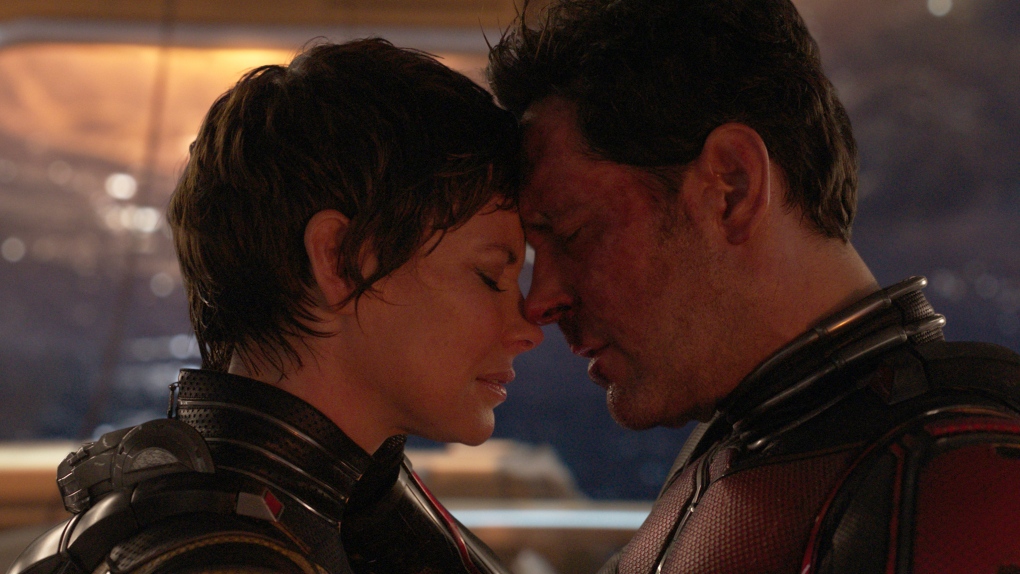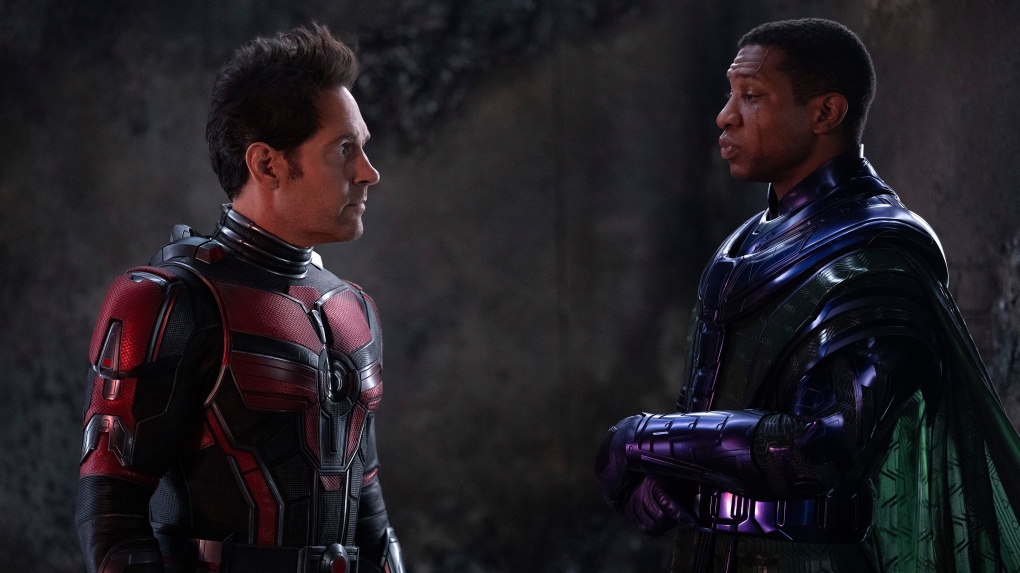ANT-MAN AND THE WASP: QUANTUMANIA: 2 ½ STARS

“Ant-Man and the Wasp: Quantumania,” now playing on theatres, kicks off Marvel’s phase five with a talky sci fi story, heavy on the scientific blather. Instead of “Quantumania,” a more appropriate subtitle could have been: More Fun Than Physics Class!
“It’s a pretty good world,” says Scott Lang (Paul Rudd), a.k.a. Ant-Man. He’s a member of the Avengers, gifted with the power of size manipulation and some funny dialogue. “I’m glad I saved it.” Basking in the glow of his heroic contributions to mankind, he’s written a book titled “Look Out for the Little Guy,” and shamelessly drinks in the praise of his friends and fans.
His family, however, thinks he is resting on his laurels, and, in secret, are still working on ways to help the planet. His romantic partner Hope van Dyne, a.k.a. Wasp (Evangeline Lilly), daughter Cassie (Kathryn Newton) and the original Ant-Man Hank Pym (Michael Douglas), have created a sort of satellite for deep space, except it connects them to the Quantum Realm, a subatomic level where the realities of space and time don’t exist.
Having spent 30 years trapped in the subatomic world, Hope’s mother Janet (Michelle Pfeiffer) is horrified by their experiments. “Do you know how dangerous the Quantum Realm is? Turn it off now.”
Of course, Cassie and Co learn too late that the connection to the Quantum Realm goes both ways, and they are all sucked into the satellite and transported to the strange world, a place that looks like a Yes album cover from 1973 come to life.
Separated into two groups, Scott and Cassie are captured by freedom fighters led by Jentorra (Katy O’Brian), while Hope, Hank and Janet are cut loose, on the run from Janet’s old nemesis, a destroyer of worlds called Kang the Conqueror (Jonathan Majors).
Kang needs the Pym Particles, the subatomic particles developed by Hank which can increase or reduce mass as well as density and strength, to exit the Quantum Realm and travel through time and bring havoc to the real world.
Only Ant-Man and his ragtag gang can stop him and his interdimensional threat, but only if they can navigate the Quantum Realm and come together as a group.
There is a lightness of touch to “Quantumania.” Rudd’s charisma sees to that, and he provides some genuinely funny moments in the film. Majors brings the secret sauce as a great cartoon villain, but the talky script and messy action scenes suck away much of the fun.
You may be thinking, “But Michael Douglas talks to a giant ant. How can that be bad?” True enough, it is something I never would have expected to see, and I got a kick out of it, but for every nifty moment like that, there is sea of exposition, as if the filmmakers don’t trust the audience to understand what is happening unless it is spelled out for them.
The loud, CGI-overload climax fills the screen but doesn’t grab the imagination. There are cool creatures and action enough for any two movies, but it all feels thrown at the screen, willy-nilly. There is a lot of it, but none of it is memorable or particularly original.
“Ant-Man and the Wasp: Quantumania” is a let down, a movie that feels more like an introduction to the next batch of MCU movies than a standalone.
MARLOWE: 2 ½ STARS

“I intend to ask questions,” says detective Philip Marlowe (Liam Neeson) in the new gumshoe thriller “Marlowe,” now playing in theatres. And ask questions he does. This revisiting of the classic hardboiled 1930s P.I. Philip Marlowe, made famous on the big screen by Humphrey Bogart, isn’t so much a story as it is a very long series of questions strung together to tell the tale. Screenwriter William Monahan, adapting “The Black-Eyed Blonde,” a 2014 authorized Marlowe novel by Irish writer John Banville, must have burned out the “?” key on his typewriter.
Set in Hollywood, in 1939, the same year Raymond Chandler published “The Big Sleep,” his first Marlowe novel, the movie begins when Clare Cavendish (Diane Kruger) hires the detective to find her missing lover, Nico Petersen (François Arnaud). A prop master at one of the studios, he makes extra cash smuggling drugs into the United States in the props he imports from Mexico.
The police say Nico was killed in a hit and run outside a fancy private club, Cavendish thinks he is still alive and Marlowe has questions. Lots of questions.
When “Marlowe” isn’t in Q&A mode, it has, if nothing else, a collection of interesting characters. Jessica Lange makes an impression as a secretive former movie star who just might be her daughter’s love rival, Danny Houston redefines creepy bluster as a pimp at the upmarket Corbata Club but it is Alan Cumming who leaves a lasting impression. He is businessman, philanthropist and gangster Lou Hendricks, a chewer of scenery who delivers lines like, “I am entirely composed of tarantulas,” with the gusto of a Marvel villain.
Neeson gives the title character a world weariness that borders on ennui. In the Raymond Chandler books he is portrayed in his 30s and 40s. Neeson is 70 and, as Marlowe, is still able to take on a room full of bad guys with his fists and his wits, but he’s seen too much of the underside of life, and it has left him cynical, disengaged to the evil that men do. “I’m getting too old for this,” he says after dispatching a group of baddies, and given Neeson’s listless performance, he may be right.
“Marlowe” has the look and feel of an old time Hollywood noir, but is a pale imitation of the real thing. The golden haze that hangs over every frame can’t disguise the fact that this is a movie comprised of a series of questions with unsatisfying answers in search of a meaningful story.
THE OTHER FELLOW: 4 STARS
There’s an old proverb that reads, “Words have meaning, names have power.” “The Other Fellow,” a new documentary now paying in select theatres and on VOD, examines the power, along with the blessings, curses and the potentially life changing effects, of sharing a name with one of the most famous fictional characters of all time, super spy James Bond.
Like any good 007 film, “The Other Fellow” hops around the globe from Canada and the United States, to Guyana, Baghdad and Sweden, among other exotic locales, to tell its story. But unlike the proper Bond movies, this globe-trotting doc isn’t about high tech gadgets or supervillains. This is a study of identity, of the power of a name, thrust upon the film’s subjects at birth, to influence the path of the bearer’s life, particularly in our digital age.
From the amusing—several “Bonds” complain about hearing the same “shaken not stirred” jokes everyday of their lives—to the sinister—a Bond who identifies as Black describes being jailed for 60 days for obstruction of justice for “playfully” saying his name to a police officer—director Matt Bauer examines the issue from several viewpoints.
The result is a funny, yet poignant film that entertains as it tackles big societal and personal issues. There’s a murder mystery, a story of abuse and a name change, all woven together to complete a portrait of how the aura of masculinity of the associated name comes loaded with challenges and unwanted attention.
Some have capitalized on the name. A New York theatre director reluctantly does a Bond style commercial for a casino, even though he has nothing in common with the character except the name. “He has a six-pack. I have a keg.”
Gunnar Schäfer, a Swedish man abandoned by his Nazi deserter father, filled the familial gap in his life with Bond, changing his name and adopting a 007 lifestyle and even opening a James Bond museum. In the embrace of the name, his story differs from the rest, but his obsession sheds light on the way a name can change the path of a life.
“The Other Fellow” isn’t a James Bond film, or a film about James Bond films. Instead, it is an intriguing and well packaged look at what it is like to be James Bond, or at least carry his name.
CAT DADDIES: 4 STARS FOR CATS LOVERS, 3 STARS FOR EVERYONE ELSE

For years there was a shorthand used in movies and television. If the character was a good person, they had a pet dog. If they were evil, treacherous or otherwise up to no good, they had a pet cat. For instance, “Legally Blonde’s” Elle Woods had Bruiser the Chihuahua. The Queen of Hearts, however, hung with the Cheshire Cat. John Wick had the late, lamented Daisy, while Dr. Evil had the slinky feline Mr. Bigglesworth.
A new documentary aims to break that stereotype by portraying a different take on man’s new best friend, the cat.
Director Mye Hoang cobbles together disconnected stories of cat lovers from all over the United States—an actor, a stunt performer, an unhoused man, firefighters, a truck driver, a software engineer, an influencer and an advertising executive—to create what may be the ultimate cat video.
The thing that binds the stories is the sense of community that the cats provide, whether it is the story of David, an unhoused man whose cat Lucky was the catalyst to friendships and a better life, or trucker David Durst, who arranges meet-and-greets with his social media star cat while he is on the road.
In each of these stories, the felines are the glue that binds their owners to a larger community and while there is loads of cute cat footage, it is the human aspect of each that resonates. It’s about compassion, a trait that seems to flow easily back-and-forth between owner and pet. In other words, the owners get as much out of their feline relationships as the cats do.
“Cat Daddies” is a beautiful looking film—a cut or three above the usual YouTube cat video—but, for all its amiability and empathy, it is a slight piece of work. The stories vary in poignancy and aren’t all equally captivating. Still, for cat lovers there is enough heartwarming feline action to earn a recommend and if you’re a dog lover, this just might change your catitude






More Stories
Kim Kardashian to join Kamala Harris at White House to talk criminal justice
Tim Hortons to stage theatrical production called ‘The Last Timbit’ | Globalnews.ca
Harvey Weinstein’s 2020 rape conviction in New York overturned | CBC News